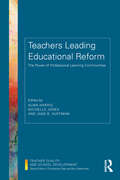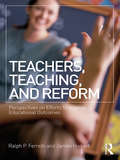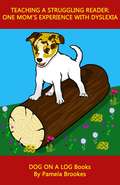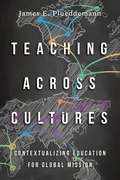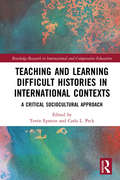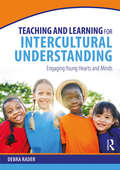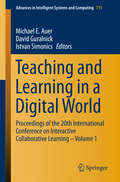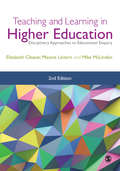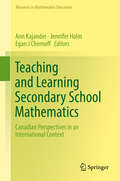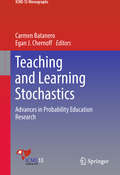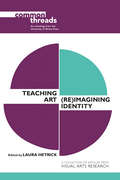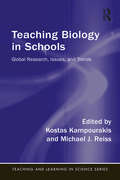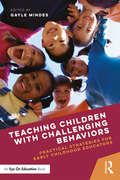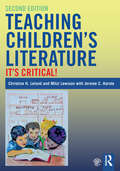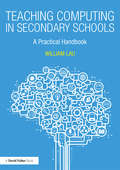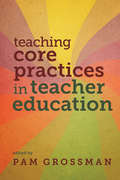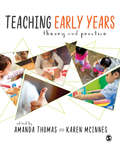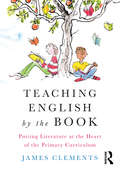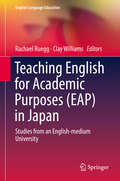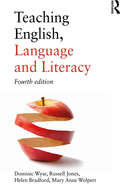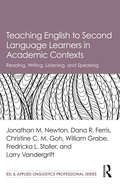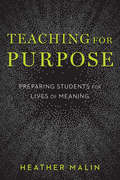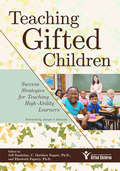- Table View
- List View
Teachers Leading Educational Reform: The Power of Professional Learning Communities (Teacher Quality and School Development)
by Alma Harris, Michelle Jones and Jane B. HuffmanTeachers Leading Educational Reform explores the ways in which teachers across the world are currently working together in professional learning communities (PLCs) to generate meaningful change and innovation in order to transform pedagogy and practice. By discussing how teachers can work collectively and collaboratively on the issues of learning and teaching that matter to them, it argues that through collective action and collaborative agency, teachers are leading educational reform. By offering contemporary examples and perspectives on the practice, impact and sustainability of PLCs, this book takes a global, comparative view showing categorically that those educational systems that are performing well, and seek to perform well, are using PLCs as the infrastructure to support teacher-led improvement. Split into three sections that look at the macro, meso and micro aspects of how far professional collaboration is building the capacity and capability for school and system improvement, this text asks the questions: Is the PLC work authentic? Is the PLC work being implemented at a superficial or deep level? Is there evidence of a positive impact on students/teachers at the school/district/system level? Is provision in place for sustaining the PLC work? Teachers Leading Educational Reform illustrates how focused and purposeful professional collaboration is contributing to change and reform across the globe. It reinforces why teachers must be at the heart of the school reform processes as the drivers and architects of school transformation and change.
Teachers, Teaching, and Reform: Perspectives on Efforts to Improve Educational Outcomes
by Ralph P. Ferretti James HiebertComprised of contributions from distinguished education scholars, Teachers, Teaching, and Reform takes a critical look at evidence about systemic efforts to identify excellent teachers and promote excellent teaching practices. Organized to include diverse and often contrasting perspectives on the topic, this book provides insight into some of the most vexing historical issues affecting the policies that shape current reform initiatives focused on teachers, teaching, and educational outcomes. Educational scholars, policy makers, instructors, and graduate students will come away with a keen understanding of different perspectives about the assessment of teachers, teaching, and teacher education programs, as well as strategies for improving educational outcomes for students.
Teaching a Struggling Reader: One Mom's Experience with Dyslexia (DOG ON A LOG Books #1)
by Pamela BrookesThere are a lot of children (and adults) who struggle with reading. Some are helped by their schools, some are not. <P><P>In this short booklet, Pamela Brookes shares some of the basic information she wishes she'd had when she was first trying to figure out how to help her child learn to read. <P><P>Teaching A Struggling Reader is filled with links to informational and product resources for parents or teachers. It is geared to people who want to educate themselves in the methods that are effective in teaching those with dyslexia. It also contains photos demonstrating basic techniques like "Tapping" (using one's fingers to aid in sounding out words) and "Making your bed" to differentiate between "b" and "d." <P><P>This Second Edition includes new information and new links. Most importantly it has information on Early Intervention, including what parents can do if they suspect their child may have dyslexia during the toddler and preschool years, and a new section on What if It's NOT Dyslexia. <P><P>The focus of this book is the reading process. However, since many readers with dyslexia also struggle with math, there is a brief description of how the dyslexic brain comes to understand math. There is also a link to a blog by Dr. Meg Burke of Dyslexia Pros. She has dyslexia and a PhD in math education. She is dedicated to helping her students attain fluency in math. <P><P>This is a booklet that can be read in one sitting. However, there are ample links to provide an even greater experience.
Teaching Across Cultures: Contextualizing Education for Global Mission
by James E. PlueddemannIn our globalized world, educators often struggle to adapt to the contexts of diverse learners. In this practical resource, educator and missiologist James Plueddemann offers field-tested insights for teaching across cultural differences. He unpacks how different cultural dynamics may inhibit learning and offers a framework for integrating conceptual ideas into practical experience.
Teaching and Learning Difficult Histories in International Contexts: A Critical Sociocultural Approach (Routledge Research in International and Comparative Education)
by Terrie Epstein Carla L. PeckGrounded in a critical sociocultural approach, this volume examines issues associated with teaching and learning difficult histories in international contexts. Defined as representations of past violence and oppression, difficult histories are contested and can evoke emotional, often painful, responses in the present. Teaching and learning these histories is contentious yet necessary for increased dialogue within conflict-ridden societies, reconciliation in post-conflict societies, and greater social cohesion in long-standing democratic nations. Focusing on locations and populations across the globe, chapter authors investigate how key themes—including culture, identity, collective memory, emotion, and multi-perspectivity, historical consciousness, distance, and amnesia—inform the teaching and learning of difficult histories.
Teaching and Learning for Intercultural Understanding: Engaging Young Hearts and Minds
by Debra RaderTeaching and Learning for Intercultural Understanding is a comprehensive resource for educators in primary and early years classrooms. It provides teachers with a complete framework for developing intercultural understanding among pupils and includes practical and creative strategies and activities to stimulate discussion, awareness and comprehension of intercultural issues and ideas. Drawing on the most current research and work in the field of intercultural competence and existing models of intercultural understanding, this book explores topics such as: understanding culture and language the importance of personal and cultural identity engaging with difference cultivating positive attitudes and beliefs embedding awareness of local and global issues in students designing a classroom with intercultural understanding in mind. With detailed ready-to-use, enquiry-based lesson plans, which incorporate children's literature, talking points and media resources, this book encourages the practitioner to consider intercultural understanding as another lens through which to view the curriculum when creating and choosing learning materials and activities. Teaching and Learning for Intercultural Understanding sets out to help the reader engage young hearts and minds with global and local concepts in a way that is easily integrated into the life of all primary schools – from New York to New Delhi, from Birmingham to Bangkok.
Teaching and Learning in a Digital World: Proceedings Of The 20th International Conference On Interactive Collaborative Learning - Volume 1 (Advances In Intelligent Systems And Computing #715)
by Michael E. Auer David Guralnick Istvan SimonicsThis book gathers the Proceedings of the 20th International Conference on Interactive Collaborative Learning (ICL2017), held in Budapest, Hungary on 27-29 September 2017. The authors are currently witnessing a significant transformation in the development of education. The impact of globalisation on all areas of human life, the exponential acceleration of technological developments and global markets, and the need for flexibility and agility are essential and challenging elements of this process that have to be tackled in general, but especially in engineering education. To face these current real-world challenges, higher education has to find innovative ways to quickly respond to them. Since its inception in 1998, this conference has been devoted to new approaches in learning with a focus on collaborative learning. Today the ICL conferences offer a forum for exchange concerning relevant trends and research results, and for sharing practical experience gained while developing and testing elements of new technologies and pedagogies in the learning context.
Teaching and Learning in Higher Education: Disciplinary Approaches to Educational Enquiry
by Elizabeth Cleaver Maxine Lintern Mike McLindenThis book explores best practice approaches to undertaking enquiry into learning and teaching in higher education for staff from all academic disciplines. A general introduction to the methods most commonly used in undertaking enquiry in the field of education is complemented by chapters exploring how research methods from a range of disciplinary areas can be adapted and used for educational enquiry. New to this second edition: · Chapters on interdisciplinary educational enquiry in geography and using ethnographic methods for educational enquiry · New case studies and suggested activities · A reflective final chapter inviting readers and their institutions to develop and promote an organisational culture founded on critical enquiry This is essential reading for anyone undertaking HE qualifications in learning and teaching (including PGCTLHE and PGCAP) and for academics wishing to apply their skills of research and enquiry to their learning and teaching practice.
Teaching and Learning in Higher Education: Disciplinary Approaches to Educational Enquiry
by Elizabeth Cleaver Maxine Lintern Mike McLindenThis book explores best practice approaches to undertaking enquiry into learning and teaching in higher education for staff from all academic disciplines. A general introduction to the methods most commonly used in undertaking enquiry in the field of education is complemented by chapters exploring how research methods from a range of disciplinary areas can be adapted and used for educational enquiry. New to this second edition: · Chapters on interdisciplinary educational enquiry in geography and using ethnographic methods for educational enquiry · New case studies and suggested activities · A reflective final chapter inviting readers and their institutions to develop and promote an organisational culture founded on critical enquiry This is essential reading for anyone undertaking HE qualifications in learning and teaching (including PGCTLHE and PGCAP) and for academics wishing to apply their skills of research and enquiry to their learning and teaching practice.
Teaching and Learning Secondary School Mathematics: Canadian Perspectives in an International Context (Advances in Mathematics Education)
by Ann Kajander Jennifer Holm Egan J ChernoffThis volume brings together recent research and commentary in secondary school mathematics from a breadth of contemporary Canadian and International researchers and educators. It is both representative of mathematics education generally, as well as unique to the particular geography and culture of Canada. The chapters address topics of broad applicability such as technology in learning mathematics, recent interest in social justice contexts in the learning of mathematics, as well as Indigenous education. The voices of classroom practitioners, the group ultimately responsible for implementing this new vision of mathematics teaching and learning, are not forgotten. Each section includes a chapter written by a classroom teacher, making this volume unique in its approach. We have much to learn from one another, and this volume takes the stance that the development of a united vision, supported by both research and professional dialog, provides the first step.
Teaching and Learning Stochastics: Advances In Probability Education Research (ICME-13 Monographs)
by Carmen Batanero Egan J ChernoffThis book presents a collection of selected papers that represent the current variety of research on the teaching and learning of probability. The respective chapters address a diverse range of theoretical, empirical and practical aspects underpinning the teaching and learning of probability, curricular issues, probabilistic reasoning, misconceptions and biases, as well as their pedagogical implications. These chapters are divided into THREE main sections, dealing with: TEACHING PROBABILITY, STUDENTS' REASONING AND LEARNING AND EDUCATION OF TEACHERS.In brief, the papers presented here include research dealing with teachers and students at different levels and ages (from primary school to university) and address epistemological and curricular analysis, as well as the role of technology, simulations, language and visualisation in teaching and learning probability. As such, it offers essential information for teachers, researchers and curricular designers alike.
Teaching Art: (Re)Imagining Identity (Common Threads)
by Laura HetrickA student's personal identity constantly changes as part of the lifelong human process to become someone who matters. Art educators in grades K-16 have a singular opportunity to guide important phases of this development. How can educators create a supportive space for young people to work through the personal and cultural factors influencing their journey? <P><P>Laura Hetrick draws on articles from the archives of Visual Arts Research to approach the question. Juxtaposing the scholarship in new ways, she illuminates methods that allow educators to help students explore identity through artmaking; to reinforce identity in positive ways; and to enhance marginalized identities. <P><P>A final section offers suggestions on how educators can use each essay to engage with students who are imagining, and reimagining, their identities in the classroom and beyond. Contributors: D. Ambush, M. S. Bae, J. C. Castro, K. Cosier, C. Faucher, K. Freedman, F. Hernandez, L. Hetrick, K. Jenkins, E. Katter, M. Lalonde, L. Lampela, D. Pariser, A. Pérez Miles, M., and K. Schuler. Laura Hetrick is an assistant professor of art education at the University of Illinois, Urbana-Champaign, and the coeditor of the journal Visual Arts Research.
Teaching Biology in Schools: Global Research, Issues, and Trends (Teaching and Learning in Science Series)
by Kostas Kampourakis Michael J. ReissAn indispensable tool for biology teacher educators, researchers, graduate students, and practising teachers, this book presents up-to-date research, addresses common misconceptions, and discusses the pedagogical content knowledge necessary for effective teaching of key topics in biology. Chapters cover core subjects such as molecular biology, genetics, ecology, and biotechnology, and tackle broader issues that cut across topics, such as learning environments, worldviews, and the nature of scientific inquiry and explanation. Written by leading experts on their respective topics from a range of countries across the world, this international book transcends national curricula and highlights global issues, problems, and trends in biology literacy.
Teaching Children with Challenging Behaviors: Practical Strategies for Early Childhood Educators
by Gayle MindesTeaching Children with Challenging Behaviors provides early childhood educators with a guide to developmentally appropriate practice for working with children who exhibit challenging behaviors, as well as perspectives for experienced teachers to reflect upon best practices in today’s complex world. This highly practical book addresses systemic issues such as classroom management techniques; social, emotional, and behavioral support strategies; curriculum, assessment, and utilization of technology; and bridging the existing gap between mental health providers, families, and early childhood professionals. Written in nontechnical language with support from current research, this book will help you navigate the sometimes treacherous terrain of teaching children with challenging behaviors.
Teaching Children's Literature: It's Critical!
by Christine H. Leland Mitzi Lewison Jerome C. HarsteInviting multiple ways of critically engaging with literature, this text offers a fresh perspective on how to integrate children’s literature into and across the curriculum in effective, purposeful ways. Structured around three "mantras" that build on each other—Enjoy; Dig deeply; Take action—the book is rich with real examples of teachers implementing critical pedagogy. The materials and practical strategies focus on issues that impact children’s lives, building from students’ personal experiences and cultural knowledge to using language to question the everyday world, analyze popular culture and media, understand how power relationships are socially constructed, and consider actions that can be taken to promote social justice. Written for teachers and teacher educators, each chapter opens with three elements that are closely linked: classroom vignettes showcasing the use of literature and inviting conversation; three key principles elaborating the main theme of the chapter and connecting theory with practice; and related research on the topics and their importance for curriculum. Other chapter features include key issues in implementation, suggestions for working with linguistically and culturally diverse students, alternative approaches to assessment, and suggestions for further reading. A companion website to enrich and extend the text includes an annotated bibliography of literature selections, suggested text sets, resources by chapter, and ideas for professional development. Changes in the Second Edition: Voices from the Field vignettes include examples from inspiring educators who use trade books to promote critical thinking and diversity Updated chapters include information on new technology and electronic resources New references in the principles sections and new resources for further study New children’s books added throughout the chapters as well as to the companion website
Teaching Computing in Secondary Schools: A Practical Handbook
by William LauThis book provides a step-by-step guide to teaching computing at secondary level. It offers an entire framework for planning and delivering the curriculum and shows you how to create a supportive environment for students in which all can enjoy computing. The focus throughout is on giving students the opportunity to think, program, build and create with confidence and imagination, transforming them from users to creators of technology. In each chapter, detailed research and teaching theory is combined with resources to aid the practitioner, including case studies, planning templates and schemes of work that can be easily adapted. The book is split into three key parts: planning, delivery, and leadership and management, and covers topics such as: curriculum and assessment design lesson planning cognitive science behind learning computing pedagogy and instructional principles mastery learning in computing how to develop students’ computational thinking supporting students with special educational needs and disabilities encouraging more girls to study computing actions, habits and routines of effective computing teachers behaviour management and developing a strong classroom culture how to support and lead members of your team. Teaching Computing in Secondary Schools is essential reading for trainee and practising teachers, and will prove to be an invaluable resource in helping teaching professionals ensure that students acquire a wide range of computing skills which will support them in whatever career they choose.
Teaching Core Practices in Teacher Education (Core Practices in Education Series)
by Pam GrossmanIn Teaching Core Practices in Teacher Education, Pam Grossman and her colleagues advocate an approach to practice-based teacher education that identifies &“core practices&” of teaching and supports novice teachers in learning how to enact them competently. Examples of core practices include facilitating whole-class discussion, eliciting student thinking, and maintaining classroom norms. The contributors argue that teacher education needs to do more to help teachers master these professional skills, rather than simply emphasizing content knowledge. Teaching Core Practices in Teacher Education outlines a series of pedagogies that teacher educators can use to help preservice students develop these teaching skills. Pedagogies include representations of practice (ways to show what this skill looks like and break it down into its component parts) and approximations of practice (the ways preservice teachers can try these skills out as they learn). Vignettes throughout the book illustrate how core practices can be incorporated into the teacher education curriculum. The book draws on the work of a consortium of teacher educators from thirteen universities devoted to describing and enacting pedagogies to help novice teachers develop these core practices in support of ambitious and equitable instruction. Their aim is to support teacher educator learning across institutions, content domains, and grade levels. The book also addresses efforts to support teacher learning outside formal teacher education programs.Contributors Chandra L. Alston Andrea Bien Janet Carlson Ashley Cartun Katie A. Danielson Elizabeth A. Davis Christopher G. Pupik Dean Brad Fogo Megan Franke Hala Ghousseini Lightning Peter Jay Sarah Schneider Kavanagh Elham Kazemi Megan Kelley-Petersen Matthew Kloser Sarah McGrew Chauncey Monte-Sano Abby Reisman Melissa A. Scheve Kristine M. Schutz Meghan Shaughnessy Andrea Wells
Teaching Early Years: Theory and Practice
by Amanda Thomas Karen McInnesThis textbook focuses on the main areas of teaching young children, covering the 3-7 years age range that spans the early years and primary phases. The majority of chapters are written by both an academic and practitioner, reflecting a genuine theory and practice approach, and this helps the reader to set theoretical discussion in the context of real practice. Key themes explored within the book include: - Play and playfulness in the curriculum - Child development in practice - Literacy development and subject pedagogy - Creativity and outdoor learning Packed full of learning features such as case studies, reflective questions and lesson plans, Teaching Early Years is an essential resource for both students and practitioners, and will enhance your knowledge of how young children think and learn.
Teaching Early Years: Theory and Practice
by Amanda Thomas Karen McInnesThis textbook focuses on the main areas of teaching young children, covering the 3-7 years age range that spans the early years and primary phases. The majority of chapters are written by both an academic and practitioner, reflecting a genuine theory and practice approach, and this helps the reader to set theoretical discussion in the context of real practice. Key themes explored within the book include: - Play and playfulness in the curriculum - Child development in practice - Literacy development and subject pedagogy - Creativity and outdoor learning Packed full of learning features such as case studies, reflective questions and lesson plans, Teaching Early Years is an essential resource for both students and practitioners, and will enhance your knowledge of how young children think and learn.
Teaching English by the Book: Putting Literature at the Heart of the Primary Curriculum
by James ClementsTeaching English by the Book is about putting great books, wonderful poems and rich texts at the heart of English teaching, transforming children’s attitudes to reading and writing and having a positive impact on learning. It offers a practical approach to teaching a text-based curriculum, full of strategies and ideas that are immediately useable in the classroom. Written by James Clements, teacher, researcher, writer, and creator of shakespeareandmore.com, Teaching English by the Book provides effective ideas for enthusing children about literature, poetry and picturebooks. It offers techniques and activities to teach grammar, punctuation and spelling, provides support and guidance on planning lessons and units for meaningful learning, and shows how to bring texts to life through drama and the use of multimedia and film texts. Teaching English by the Book is for all teachers who aspire to use great books to introduce children to ideas beyond their own experience, encounter concepts that have never occurred to them before, to hear and read beautiful language, and experience what it’s like to lose themselves in a story, developing a genuine love of English that will stay with them forever.
Teaching English for Academic Purposes: Studies From An English-medium University (English Language Education #14)
by Rachael Ruegg Clay WilliamsThis book focuses on appropriate English for Academic Purposes instructional concepts and methods in the Japanese context. It investigates a variety of pedagogical techniques, addressing the fundamental academic English skills – listening, speaking, reading and writing – as well as assessment and materials development. All the research included was conducted in Japanese university settings, thus shedding new light on the effective implementation of EAP teaching and learning activities with Japanese learners of English. This book is of interest to anyone working in an EAP context at the secondary or tertiary level, especially those which include Japanese learners.
Teaching English, Language and Literacy (Routledge International Handbooks Of Education Ser.)
by Dominic Wyse Russell Jones Helen Bradford Mary Anne WolpertAre you looking for one book that gives a comprehensive account of primary and early years English, language and literacy teaching? This fully revised fourth edition of Teaching English, Language and Literacy includes up-to-date research and updated discussion of effective teaching. Throughout the book there is guidance on England’s new National Curriculum and its impact. Rooted in research evidence and multidisciplinary theory, this book is an essential introduction for anyone learning to teach English from the early years to primary school level. The authors draw on their research, scholarship and practice to offer advice on: inclusion and equality, including working effectively with multilingual pupils speaking and listening developing reading, including choosing texts, and phonics teaching improving writing, including grammar and punctuation planning and assessing the latest thinking in educational policy and practice the use of multimedia maintaining good home--school links All the chapters include examples of good practice, coverage of key issues, analysis of research and reflections on national policy to encourage the best possible response to the exciting challenges of teaching. Each chapter also has a glossary to explain terms and gives suggestions for further reading. This authoritative book is for all those who want to improve the teaching of English, language and literacy in schools. Designed to help inform trainee teachers and tutors, but also of great use to those teachers wanting to keep pace with the latest developments in their specialist subject, this is an indispensable guide to the theory and practice of teaching English, language and literacy.
Teaching English to Second Language Learners in Academic Contexts: Reading, Writing, Listening, and Speaking (ESL & Applied Linguistics Professional Series)
by Jonathan M. Newton Dana R. Ferris Christine C.M. Goh William Grabe Fredricka L. Stoller Larry VandergriftTeaching English to Second Language Learners in Academic Contexts: Reading, Writing, Listening, and Speaking provides the fundamental knowledge that ESL and EFL teachers need to teach the four language skills. This foundational text, written by internationally renowned experts in the field, explains why skills-based teaching is at the heart of effective instruction in English for academic purposes (EAP) contexts. Each of the four main sections of the book helps readers understand how each skill—reading, writing, listening, and speaking—works and explains what research has to say about successful skill performance. Pedagogically focused chapters apply this information to principles for EAP curriculum design and to instructional activities and tasks adaptable in a wide range of language-learning contexts. Options for assessment and the role of digital technologies are considered for each skill, and essential information on integrated-skill instruction is provided. Moving from theory to practice, this teacher-friendly text is an essential resource for courses in TESOL programs, for in-service teacher-training seminars, and for practicing EAP teachers who want to upgrade their teaching abilities and knowledge bases.
Teaching for Purpose: Preparing Students for Lives of Meaning
by Heather MalinIn Teaching for Purpose, Heather Malin explores the idea of purpose as the purpose of education and shows how educators can prepare youth to live intentional, fulfilling lives. The book highlights the important role that purpose—defined as &“a future-directed goal that is personally meaningful and aimed at contributing to something larger than the self&”—plays in optimal youth development and in motivating students to promote the cognitive and noncognitive skills that teachers want to instill. Based on a decade of research conducted at the Stanford University Center on Adolescence, the book explores how educators and schools can promote purpose through attention to school culture, curriculum, project learning, service learning, and other opportunities. Malin argues for expansive thinking on the direction schools should take, especially in terms of educating students to be creative, innovative, and self-directed critical thinkers. The book includes profiles of six organizations working in schools across the US that have made purpose development a priority. Infused with the engaging voices of purposeful youth, Teaching for Purpose offers a fresh, inspirational guide for educators who are looking for new ways to support students to succeed not only in school, but in life.
Teaching Gifted Children: Success Strategies for Teaching High-Ability Learners
by Jeff Danielian Elizabeth Fogarty C. FugateFrom the pages of Teaching for High Potential, a quarterly publication of the National Association for Gifted Children, this collection of articles is sure to be of use to any educator of high-ability students. Topics included range from instructional methods across all content areas, including tips and tools for reading and vocabulary instruction, integrating STEM content, and engaging students in math, to identification, differentiation, and addressing gifted students' social-emotional needs. Articles also delve into current issues pertinent to the field of gifted education and this unique group of students, including underachievement and underrepresented minority populations, as well as new classroom strategies such as Makerspaces and teaching growth mindset. This resource can be used to enhance a classroom lesson, guide curriculum development, or supplement professional development. The featured articles are unique, well written for the audience, and selected by reviewers who understand what teachers need.
